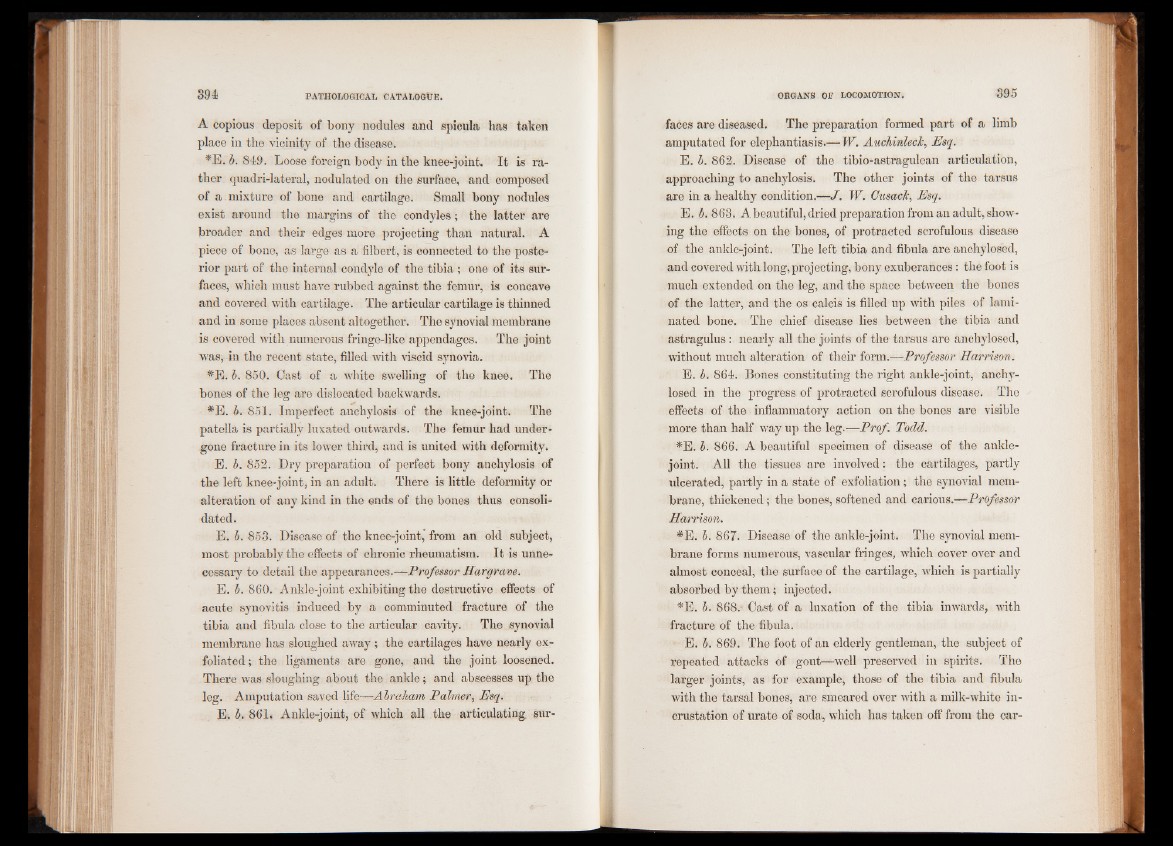
A copious deposit of bony nodules and spicula has taken
place in the vicinity of the disease.
*E. b. 849. Loose foi reign body in the knee-joint. It is rather
quadri-lateral, nodulated on the surface, and composed
of a mixture of bone and cartilage. Small bony nodules
exist around the margins of the condyles; the latter are
broader and their edges more projecting than natural. A
piece of bone, as large as a filbert, is connected to the posterior
part of the internal condyle of the tibia ; one of its Surfaces,
which must have rubbed against the femur, is concave
and covered with cartilage. The articular cartilage is thinned
and in some places absent altogether. The synovial membrane
is covered with numerous fringe-like appendages. The joint
was, in the recent state, filled with viscid synovia.
#E. b. 850. Oast of a white swelling of the knee. The
bones of the leg are dislocated backwards.
*E. b. 851. Imperfect anchylosis of the knee-joint. The
patella is partially luxated outwards. The femur had under*
gone fracture in its lower third, and is united with deformity.
E. b. 852. Dry preparation of perfect bony anchylosis of
the left knee-joint, in an adult. There is little deformity or
alteration of any kind in the ends of the bones thus consolidated.
E. b. 853. Disease of the knee-joint, from an old subject,
most probably the effects of chronic rheumatism. It is unnecessary
to detail the appearances.—Professor Hargrave.
E. b. 860. Ankle-joint exhibiting the destructive effects of
acute synovitis induced by a comminuted fracture of the
tibia and fibula close to the articular cavity. The synovial
membrane has sloughed away ; the cartilages have nearly exfoliated;
the ligaments are gone, and the joint loosened.
There was sloughing about the ankle; and abseesses up the
leg. Amputation saved lif&—Abraham Palmer, Esq.
E. b. 861. Ankle-joint, of which all the articulating, surfaces
are diseased. The preparation formed part of a limb
amputated for elephantiasis.— W. Auchinleck, Esq.
E. b. 862. Disease of the tibio-astragulean articulation,
approaching to anchylosis. The other joints of the tarsus
are in a healthy condition.—J. W. Cusack, Esq.
E. b. 863. A beautiful, dried preparation from an adult, show ing
the effects on the bones, of protracted scrofulous disease
of the ankle-joint. The left tibia and fibula are anchylosed,
and covered with long,projecting, bony exuberances : the foot is
much extended on the leg, and the space between the bones
of the latter, and the os calcis is filled up with piles of laminated
bone. The chief disease lies between the tibia and
astragulus : nearly all the joints of the tarsus are anchylosed,
without much alteration of their form.—Professor Harrison.
E. b. 864. Bones constituting the right ankle-joint, anchylosed
in the progress of protracted scrofulous disease. The
effects of the inflammatory action on the bones are visible
more than half way up the leg.—Prof. Todd.
*E. b. 866. A beautiful specimen of disease of the ankle-
joint. All the tissues are involved: the cartilages, partly
ulcerated, partly in a state of exfoliation; the synovial membrane,
thickened; the bones, softened and carious.—Professor
Harrison.
#E. b. 867. Disease of the ankle-joint. The synovial membrane
forms numerous, vascular fringes, which cover over and
almost conceal, the surface of the cartilage, which is partially
absorbed by them; injected,
*E. b. 868/ Cast of a luxation of the tibia inwards, with
fracture of the fibula.
E. b. 869. The foot of an elderly gentleman, the subject of
repeated attacks of gout—well preserved in spirits. The
larger joints, as for example, those of the tibia and fibula
with the tarsal bones, are smeared over with a milk-white incrustation
of urate of soda, which has taken off from the car